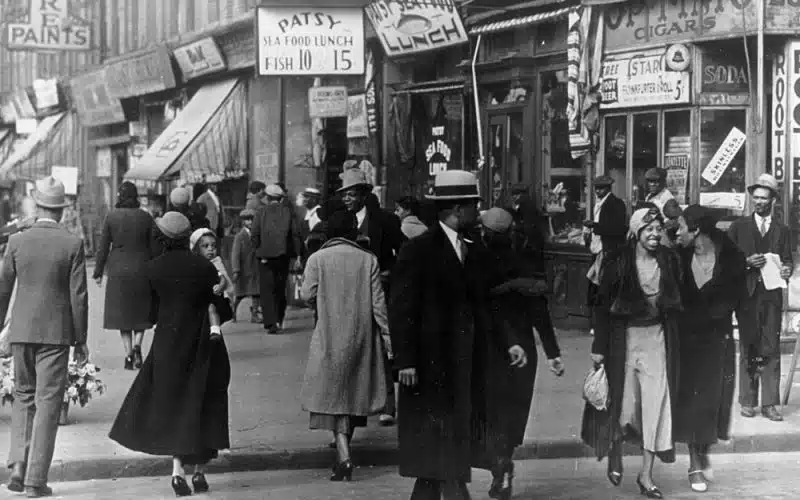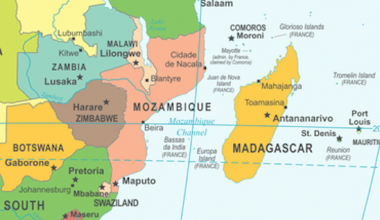Understanding the Great Migration, a monumental event in history, and its origins requires delving into a multifaceted tapestry of circumstances that compelled diverse communities to undertake this transformative journey. The Great Migration, a mass movement of African Americans from rural South to urban North and West US, was driven by escaping racial discrimination, seeking better economic opportunities, and the impact of World War I and the Harlem Renaissance. To know about why the great migration happened, its cause, and how it affected the world, you should read more of this article.
Why Did The Great Migration Happen?
The Great Migration was the mass movement of African Americans from rural communities in the South to urban areas in the North and West of the United States during the 20th century. This migration had significant causes and impacts.
Causes of the Great Migration, Why it Happened?
#1. Escaping Racial Discrimination and Violence
African Americans faced widespread racial discrimination, segregation, and violence in the South, including Jim Crow laws and lynchings. Many sought to escape these oppressive conditions and find better opportunities elsewhere.
#2. Economic Opportunities
The North and West offered more job opportunities, especially in industrial cities, due to the growth of industries during World War I and the demand for labor. African Americans hoped to find better-paying jobs and improve their economic conditions.
#3. The Impact of World War I
The war disrupted European immigration to the United States, leading to labor shortages. This created opportunities for African Americans to fill the vacant jobs in the North and West.
The Harlem Renaissance, a cultural and intellectual movement centered in Harlem, New York City, attracted African Americans with its vibrant arts scene and intellectual community. This cultural movement played a role in attracting African Americans to urban areas.
#5. The Influence of the Great Depression
The economic downturn of the Great Depression hit the South particularly hard, exacerbating poverty and unemployment. Many African Americans saw migration as a way to escape the economic hardships of the South.
After the end of slavery, many African Americans in the South became sharecroppers or tenant farmers. However, these arrangements often left them trapped in cycles of debt and poverty. The lack of economic mobility and opportunity pushed many to seek better prospects in the North and West.
#7. Recruitment Efforts by Northern Industries
As industries in the North and West grew, there was a need for a larger labor force. Northern companies actively recruited African-American workers from the South, offering better wages and living conditions. These recruitment efforts further incentivized migration.
#8. Educational Opportunities
In the South, educational opportunities for African Americans were limited and often inferior. The North and West offered better access to schools, colleges, and universities, attracting African Americans who sought to improve their education and prospects.
#9. Political Disenfranchisement
African Americans faced significant political disenfranchisement in the South due to tactics such as poll taxes, literacy tests, and violence. The lack of political power and representation fueled the desire for change and equality, leading many to migrate to urban areas where they hoped to have a stronger voice.
#10. Influence of Religious and Community Leaders
Influential religious and community leaders, such as ministers and civil rights activists, encouraged African Americans to leave the South in search of better opportunities and to escape racial discrimination. They played a significant role in mobilizing and organizing the migration movement.
Positive Impacts of the Great Migration
The Great Migration, the mass movement of African Americans from the rural South to urban areas in the North and West of the United States, had several positive impacts. Here are some of the positive effects of the Great Migration:
#1. Economic Opportunities
The migration provided African Americans with access to better job opportunities in the North and West. They found work in industries such as manufacturing, steel mills, and meatpacking plants. This allowed many individuals and families to improve their economic conditions and achieve upward mobility.
#2. Educational Opportunities
The North and West offered better access to schools, colleges, and universities compared to the segregated education system in the South. African Americans who migrated had increased opportunities for education and skill development, leading to improved career prospects and higher incomes.
#3. Political Empowerment
The Great Migration played a significant role in shaping the Civil Rights Movement. African Americans who migrated brought with them new ideas and experiences, contributing to the fight for racial equality and social justice. They became active participants in political organizations and played a crucial role in advocating for civil rights reforms.
#4. Cultural and Artistic Contributions
The Great Migration influenced the cultural landscape of the United States. African Americans who migrated brought their rich cultural traditions, music, literature, and artistic expressions to urban areas. The Harlem Renaissance, a cultural and intellectual movement centered in Harlem, New York City, emerged as a result of the Great Migration, leading to significant contributions to American arts and literature.
#5. Demographic Changes
The Great Migration led to significant demographic shifts in the United States. By 1970, the South was home to only half of the country’s black population, compared to nine out of every 10 in 1900. This dispersion of African Americans across different regions contributed to a more diverse and integrated society.
The Great Migration fostered the growth of vibrant black communities in urban areas. African Americans established their businesses, churches, social organizations, and cultural institutions. These communities provided support networks, promoted social cohesion, and contributed to the overall development of American society.
#7. Health Improvements
Research suggests that the Great Migration had positive effects on the health and mortality rates of African Americans. Moving from the rural South to urban areas with better access to healthcare and improved living conditions led to improved health outcomes for migrants.
The Great Migration played a crucial role in fueling political and social activism among African Americans. The experiences of migration and the exposure to new ideas and opportunities in urban areas inspired many individuals to become active participants in the fight for civil rights and social justice. The migration contributed to the growth of influential civil rights organizations and leaders who played a significant role in advancing the cause of racial equality.
#9. Integration and Diversity
The Great Migration contributed to the integration and diversity of American society. As African Americans migrated to urban areas, they interacted with people from different racial, ethnic, and cultural backgrounds. This interaction fostered a greater understanding and appreciation of diversity, leading to a more inclusive society.
#10. Economic Growth and Development
The influx of African-American migrants into urban areas contributed to the economic growth and development of those regions. African Americans filled labor shortages in industries, contributing to the expansion of the manufacturing and service sectors.
Negative Impacts of the Great Migration
#1. Housing Discrimination
African Americans who migrated during the second phase of the Great Migration faced housing discrimination. Localities implemented restrictive covenants and redlining, creating segregated neighborhoods and limiting access to quality housing. This contributed to the existing racial disparities in wealth and perpetuated residential segregation.
#2. Disruption of Communities
The migration resulted in the disruption of established communities in the South. As individuals and families left their hometowns, social networks and community structures were weakened or dismantled. This loss of community cohesion had negative social and cultural consequences.
#3. Loss of Agricultural Labor
The migration led to a significant loss of agricultural labor in the rural South. This had adverse effects on the agricultural economy, particularly for those who remained in the South and relied on agriculture for their livelihoods.
#4. The strain on Urban Infrastructure
The influx of a large number of migrants placed a strain on the infrastructure of urban areas. Housing, transportation, healthcare, and other public services often struggled to keep up with the rapid population growth, leading to overcrowding and inadequate resources in some instances.
#5. Increased Competition for Jobs
The migration resulted in increased competition for jobs in urban areas. African Americans who migrated often faced challenges in securing employment due to discrimination and prejudice. This competition for limited job opportunities sometimes led to tensions and conflicts between different racial and ethnic groups.
#6. Loss of Cultural Heritage
The migration resulted in the loss of cultural heritage and traditions in the rural South. As individuals and families moved to urban areas, they often had to adapt to new environments and assimilate into different cultural norms, leading to the erosion of some aspects of their original cultural identity.
The migration often meant leaving behind established social support networks, such as extended family and close-knit communities. This loss of support systems could lead to feelings of isolation and a lack of community cohesion in new urban environments.
#8. Economic Exploitation
African American migrants often faced economic exploitation in the form of low wages, poor working conditions, and limited opportunities for advancement. Many were forced to take on low-skilled and low-paying jobs, leading to economic struggles and perpetuating cycles of poverty.
#9. Strains on Public Services
The rapid influx of migrants placed strains on public services in urban areas, such as schools, healthcare facilities, and transportation systems. These services often struggled to keep up with the increased demand, leading to overcrowding, inadequate resources, and disparities in access to essential services.
#10. Health Disparities
African Americans who migrated faced health disparities in urban areas. They often encountered limited access to quality healthcare, leading to higher rates of certain health conditions and poorer health outcomes compared to their white counterparts.
Cities Affected During the Great Migration
During the Great Migration, African Americans relocated from the rural South to various cities and towns in the North, Midwest, and West of the United States.
Notable destinations that experienced significant population growth as a result of the Great Migration
#1. New York City
New York City attracted a large number of African-American migrants, particularly in the Harlem neighborhood of Manhattan. Harlem became a cultural hub for African Americans, giving rise to the Harlem Renaissance.
#2. Chicago
Chicago was another major destination for African-American migrants. They settled in neighborhoods such as Bronzeville, contributing to the growth of a vibrant black community and cultural scene.
#3. Detroit
Detroit saw a significant influx of African American migrants, who found employment opportunities in the city’s booming automobile industry.
#4. Philadelphia
Philadelphia also experienced an increase in its African-American population during the Great Migration. African Americans settled in neighborhoods like South Philadelphia and North Philadelphia.
#5. St. Louis
St. Louis attracted African-American migrants, who found employment in industries such as manufacturing and meatpacking.
#6. Pittsburgh
Pittsburgh saw an influx of African-American migrants, who worked in the city’s steel mills and other industrial sectors.
#7. Los Angeles
African American migrants also made their way to Los Angeles, seeking economic opportunities and a chance to escape racial discrimination.
#8. San Francisco and Oakland
These cities on the West Coast also experienced an increase in their African-American populations during the Great Migration.
#9. Cleveland
Cleveland, Ohio, experienced an influx of African-American migrants, who found employment opportunities in industries such as steel and manufacturing.
#10. Boston
African Americans migrated to Boston, Massachusetts, seeking economic opportunities. They settled in neighborhoods such as Roxbury and Dorchester.
What Were the Negative Effects of the Great Migration?
The Great Migration had negative effects on African Americans, including health disparities, shortened lifespans, economic exploitation, dislocation, housing discrimination and segregation, racial tensions and discrimination, and strains on urban infrastructure and public services. However, it is important to note that the Great Migration also had positive impacts, such as economic opportunities, educational advancements, political empowerment, cultural contributions, and demographic changes.
What Ended the Great Migration?
The Great Migration ended in the 1970s when the South had undergone significant changes. African Americans were no longer under pressure to leave the South and were free to live anywhere they chose. The migration came to a close as African Americans were drawn to job opportunities, a lower cost of living, and a sense of connection to their ancestral homeland, resulting in what is known as a reverse migration.
What Were The Two Major Effects of the Great Migration?
The Great Migration had two major effects: a significant demographic shift as African Americans moved from the rural South to urban areas in the North, Midwest, and West, and a cultural and social transformation marked by the development of vibrant cultural movements, the growth of African American institutions, and increased civil rights activism and political empowerment.
What Are the Three Main Causes of the Great Migration?
The three main causes of the Great Migration were economic factors, social and political factors, and demographic factors. Economic factors included limited job opportunities, low wages, and the desire for better employment and higher wages. Social and political factors encompassed racial segregation, oppressive Jim Crow laws, racial violence, and the denial of civil rights and voting rights. Demographic factors involved the boll weevil infestation that devastated the agricultural economy of the South, as well as the demand for workers during World War I and World War II.
Why Did The Great Migration Fail?
The Great Migration cannot be considered a failure, as it was a significant movement that brought about demographic, cultural, and social changes. However, it faced challenges and limitations. Some reasons why the Great Migration encountered difficulties include housing discrimination, limited economic opportunities, and continued racial inequality and segregation in the North, Midwest, and West. Despite these challenges, the Great Migration played a crucial role in shaping African-American history and laying the groundwork for future civil rights movements.
How Many People Died In The Great Migration?
The exact number of deaths related to the Great Migration is not certain but it is clear that the migration had significant implications for the mortality of African Americans.
Conclusion
The Great Migration, a mass movement of African Americans from the rural South to urban areas in the North and West, had several positive impacts. The movement also shaped the Civil Rights Movement and influenced the cultural landscape. This led to racial disparities in wealth, weakened social networks, and weakened agricultural economies. The migration also led to cultural erosion. During the Great Migration, African Americans relocated from the rural South to North, Midwest, and West cities, resulting in significant population growth in cities like New York City, Chicago, Detroit, Philadelphia, and St. Louis.






